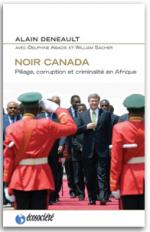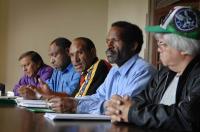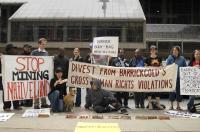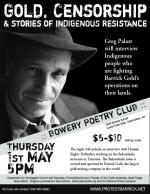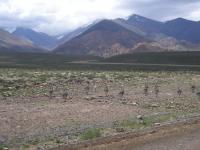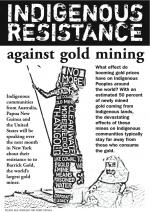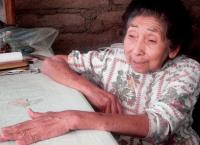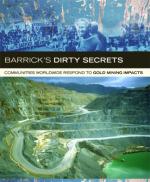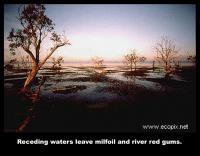Activists shame Barrick Gold at AMREF Gala Tonight a number of activists with Protest Barrick Toronto crashed an African Medical Research and Education Foundation (AMREF) gala, for which Barrick was a "Gold" sponsor. While not criticizing AMREF work, the protesters were critical of the NGO's praise of Barrick's work in Africa. They passed out fliers to gala participants until they were escorted out by AMREF security.
They highlighted the still unresolved Bulyanhulu massacre, the forced displacement of hundreds of thousands of people at the Bulyanhulu and Buzwagi mines, the current jailing of 13 villagers for protesting displacement at Barrick's Buzwagi mine, and the lack of tax revenues that goes to the people of Tanzania. These issues have previously been highlighted by reputable Tanzanian organizations such as the Lawyer's Environmental Action Team (LEAT) and Norwiegan Church Aid in Tanzania. Read "A Golden Opportunity? Justice and Respect in Mining," written by Mark Curtis and Tundu Lissu, published by Christian Council of Tanzania (CCT), National Council of Muslims in Tanzania (BAKWATA), and Tanzania Episcopal Conference. Read LEAT's response to the CAO report on the Bulyahulu mine. View LEAT's page on Barrick's Bulyanhulu Mine.
| ||
�cosoci�t� forms Solidarity website to combat from Barrick SLAPP suit The world's largest gold mining company is claiming from the small not-for-profit publisher and the authors of "Noir Canada", $5 million in compensatory damages, and $1 million in punitive damages, which represent 25 times the annual operating revenue of �cosoci�t�.http://slapp.ecosociete.org/en find out what you can do to help!
| ||
Barrick Gold censors Indigenous Leaders' opposition to gold mining on their lands Read More » | ||
International Indigenous leaders attend Barrick Gold's Shareholder's meeting Read More » | ||
Protesters Demand Accountability Outside Barrick Gold's AGM Read More » | ||
Barrick Gold Secretly Building Roads to Attack Mt. Famatina in La Rioja, Argentina On the one-year anniversary of the road blockade in Pe�a Negra and "ouster" of Barrick Gold from the Famatina mountain range, it has been confirmed that Barrick Gold, with the complicity of the national and provincial government, has been secretly constructing a new entry road into the backside of the mountain.Read More » | ||
Gold, Censorship: and stories of Indigenous Resistance
Greg Palast will interview Indigenous People who are fighting Barrick Gold's operations on their lands.
Read More » | ||
Argentina National Ombudsperson: Suspend Mining Operations in San Guillermo National Park Barrick's Pascua-Lama and 10 mining projects others in jeopardySan Juan, Argentina: Argentine national Ombudsperson Eduardo Mondino has recommended that metals mining exploration and operations be immediately suspended in a zone in the northwest of the province of San Juan. The report is based upon evidence presented in a lawsuit filed by environmentalist Ricardo Vargas in the Argentine supreme court.
| ||
Meet the Resistance: a speaking tour of affected Indigenous communities
This April and May, hear voices of communities directly affected by the operations of Barrick Gold. "Meet the Resistance" brings together community voices from Australia, Papua New Guinea, the U.S., and Chile to share their experiences in going up against the world's largest gold miner.
Check more link for schedule! see bios for the presenters.
| ||
Wiradjuri Elder exposes mine pit collapse at Lake Cowal | ||
Countering the Corporate Spin: Activists crash Barrick's forum on "Canada's Responsibility Abroad" Thursday, September 6 kicked off Merrill Lynchs Canada's 13th Annual Mining Conference, an invitation-only conference for institutional investors, mining analysts and the executive management of North American mining companies. During this conference, the Canadian Institute for International Affairs hosted a forum on "Canada's Responsibility Abroad," a meeting stacked with industry representatives, attended by a government agency, and organized to promote Corporate Social Responsibility (CSR) in the mining industry. The meeting was countered by a group of protesters outside and inside the forum; the protesters demanded mandatory regulation of the mining industry and handed out information illustrating the abuses of this industry abroad, including specific critiques of Barrick Gold pointing to their repeated misrepresentation of information in an attempt to appear socially responsibile. Read More » | ||
It's Time for Second Quarter Reporting: What will Barrick hide from their shareholders this time? August 2 marks the publishing date of Barrick Gold's second quarter results. With profits down by 14 percent, the Pascua Lama project delayed, and Norway's pension fund considering pulling their investment on ethical grounds, things aren't looking good for this gold mining giant. But, are any of these developments a big surprise? There are many shareholders who might think so, but that is only because Barrick has been systematically hiding vital information from them through glaring omissions and outright lies. Read More » | ||
"Barrick's Dirty Secrets: Communities Worldwide Respond to Gold Mining's Impacts" Download the CorpWatch report, which details the struggles against Barrick Gold.
| ||
|
Este informe, perfil de Barrick Gold, la mayor empresa minera aur�fera del mundo, es una ilustraci�n de los problemas que causa en la actualidad la industria del oro. En estas p�ginas, se presentan numerosos ejemplos donde los intereses de Barrick y los intereses de las comunidades en cuyo interior la empresa realiza sus explotaciones, van unos en contra de otros frontalmente. Desde evitar toda responsabilidad por la destructiva herencia ambiental que dejan sus proyectos o aliarse a pol�ticos corruptos, hasta recurrir a la polic�a para que reprima con violencia (y que a veces mate) a los cr�ticos de la actividad minera, el poder de Barrick en estas luchas configura un caso que exige intervenci�n urgente. Entre los grupos comunitarios que luchan contra Barrick se cuentan desde autoridades gubernamentales y tribales locales hasta asambleas de madres contra la miner�a y otros grupos de base que atraen miles de adherentes. La valerosa entrega de estos activistas a su obra es asimismo peligrosa y agotadora, y sirve para ilustrar la realidad concreta de Barrick y otras empresas similares. No hace falta decir que esta perspectiva sobre la miner�a, que tan escasa resonancia tiene, no presagia nada bueno para la industria en su totalidad, ya que procede de quienes se hallan afectados de cerca por sus explotaciones. Read More » | ||
Protests and Strike precede Barrick Gold�s 3rd quarter shareholders meeting Lea el articulo en espa�ol. On one side of the world in Chile, over a thousand people went into the streets with c�ostumes, music, and dancing to protest the proposed Pascua Lama gold project � a multi-billion dollar project that Barrick has been boasting since the late 90�s � which threatens the fertile Huasco Valley. Meanwhile, almost the same number of strikers at Barrick�s Bulyanhulu mine i�n Tanzania refused to work after negotiations with Barrick management brokedown over salaries, working conditions, medical care and other contentious issues. Within four days, Barrick fired every striking worker.
Remembering when Pascua Lama Opposition was Mainstream
Firing the Opposition will only make it burn Stronger In Tanzania, it has been almost ten years since an estimated 30,000-400,000 small-scale miners were forced off the Buyanhulu mine site to make way for corporate mining. But this week�s decision to fire the thousand striking miners will no doubt rekindle this historic resentment. The deal to take this mining concession away from these small-scale miners was brokered by Sutton Resources� CEO James Sinclair, who was a friend of the president of Tanzania and several senior ministers, as was his daughter.
| ||
Mine water use apparently ignored in water crisis Aboriginal elders and environmental activists are calling for mining in the Lachlan Catchment of New South Wales to be halted as the Wyangala Dam dries up. | ||
** BARRICK MINING DISASTERS - Emergency Funds Needed ** Read More » | ||
Activists protest open-pit mines by staking claim to Mount Royal NOTE: While this article mentions the presence of community representatives from Mexico, Honduras, Chile, Papua New Guinea, Argentina and Malartic, Quebec. The communities organized against Barrick � from Argentina, Chile, and Papua New Guinea � were the only communities whose struggles were not mentioned in the body of this article. The Quebec government's decision to protect the famed Mount Royal from mining companies didn't deter a group of activists from staking their own claims to the Montreal landmark yesterday. In an effort to draw attention to the many international communities that are forced to live beside Canadian-operated open-pit gold mines, the activists sealed off a large swath of Mount Royal, which dominates the city's landscape. Dressed in hard hats and white coveralls - the logo of their mock company RoyalOr emblazoned on the back - and toting tape, stakes and surveying equipment, the activists neatly placed the legal documentation affirming their mining rights claim in an envelope addressed to the province's Natural Resources Department and toasted their feat with a bottle of champagne. "It's going to be a beautiful, beautiful open-pit mine," actor-cum-activist Jason McLean told the group of about 80 participants. "Imagine a big hole right here. "Yes, we'll have evictions. ... nobody will suffer. Everyone will be okay with a mine in Montreal." The participants included activists from Mexico, Honduras, Chile, Papua New Guinea, Argentina and Malartic, Que. - all of whom are fighting Canadian gold mining companies that have set up in their communities. Carlos Amador of Honduras said local residents in Valle de Siria are suffering a variety of health problems due to water contamination from mines, while farmers have seen their businesses collapse as rivers and wells have dried out because of the mine's massive consumption of water. Enrique Rivera Sierra of Mexico said while communities have won court cases against Canadian mining companies, corrupt government officials have allowed environmental and land title abuses to persist and those who speak out have faced beatings, death threats and worse. Meanwhile, Nicole Kirouac of the 3,800-strong town of Malartic said the mining project in her community in northwestern Quebec has forced the relocation of 200 families and the destruction of five of the town's eight public buildings. Yesterday's stunt, aimed at drawing attention to the perils of open-pit gold mining and calling for changes to mining laws, drew the attention of the provincial government. On Friday, the department responsible for mines declared Mount Royal a protected zone that is off limits to surveyors. A department spokeswoman said it was simply an added precaution as the landmark was declared a historic site in 2005. "We effectively imposed an additional moratorium but, regardless, a mining company couldn't just stake a claim on Mount Royal without permission from the city [which owns the land] and the Culture Department because it's a historic site," Jolyane Pronovost said. Daviken Studnicki-Gizbert, a McGill University professor of Mexican history and one of the event organizers, saw it as a small victory. "The message is to start thinking about what's actually happening elsewhere in the world, what's happening in Quebec and Ontario," he said. Noting Ontario is the only province so far to look at modernizing its archaic mining laws, he called on Quebec and other provinces to do the same. His group also wants the government to provide legal recourse to international communities that are adversely affected by the mining practices of Canadian companies abroad. | ||
The Question of Sustainability An Examination of the Canadian Mining Industry: environment, cultures, and economics The Question of Sustainability Conference aims to build a movement for change within Canada. This conference provided the space for people within Canada to interact with affected communities and each other, and the conference format prioritized facilitating conversations focused on solutions to ending corporate impunity.
The Question of Sustainability is a conference dedicated to examining the Canadian mining industry through the lens of sustainability within ecosystems, human rights, culture, and economics. Featuring speakers from Papua New Guinea, Chile, the Congo, Guatemala, Tanzania and Peru, as well as many First Nations speakers and academics from Canada. This conference brings together indigenous people from the global south and the global north, and serves to address some of the complex social, political and environmental issues that relate to the imposition of extractive industries on traditional cultures. | ||
Call for Govt to reform mining sector The government has been urged to come up with a policy that will ensure people living around the mining areas enjoy the benefits accrued from their God-given resources. |


